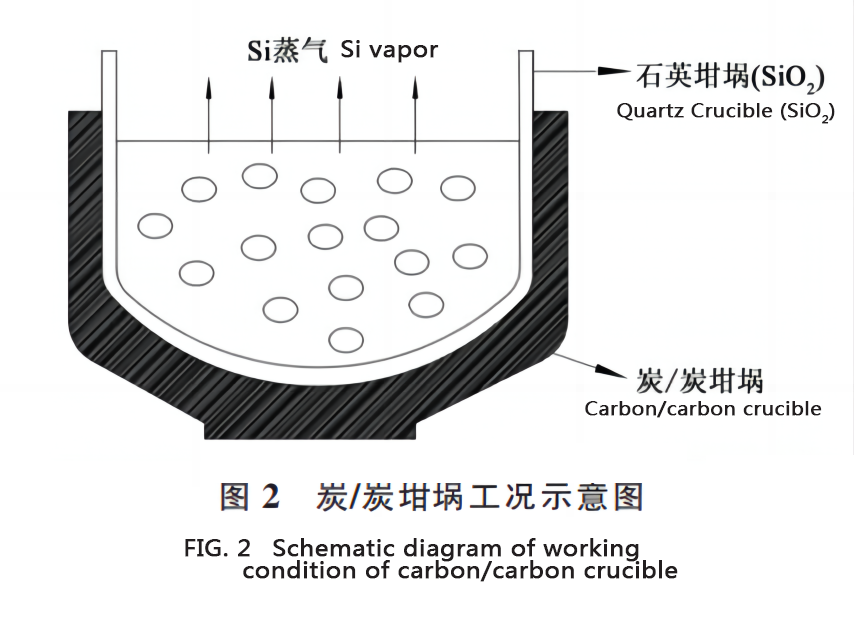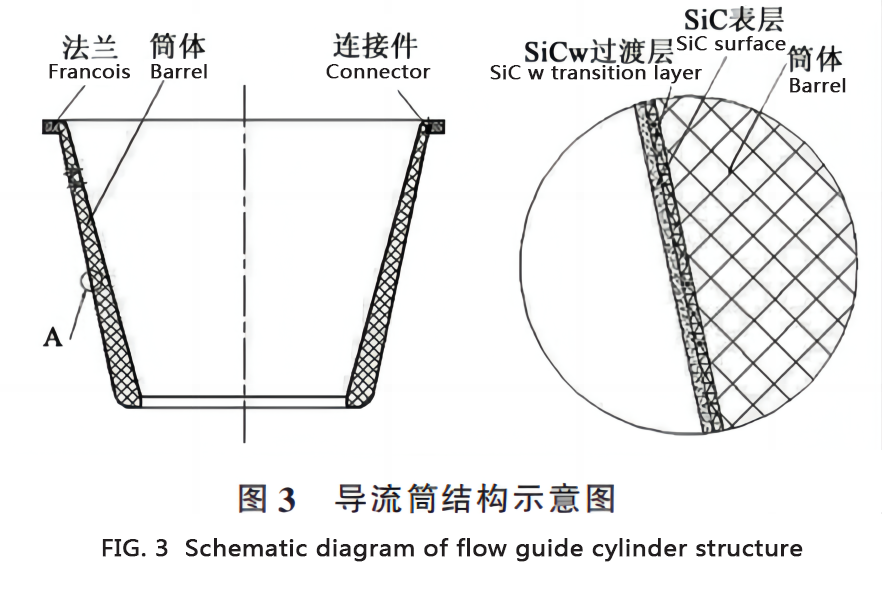1 Application and research progress of silicon carbide coating in carbon/carbon thermal field materials
1.1 Application and research progress in crucible preparation
In the single crystal thermal field, the carbon/carbon crucible is mainly used as a carrying vessel for silicon material and is in contact with the quartz crucible, as shown in Figure 2. The working temperature of the carbon/carbon crucible is about 1450℃, which is subjected to the double erosion of solid silicon (silicon dioxide) and silicon vapor, and finally the crucible becomes thin or has a ring crack, resulting in the failure of the crucible.
A composite coating carbon/carbon composite crucible was prepared by chemical vapor permeation process and in-situ reaction. The composite coating was composed of silicon carbide coating (100~300μm), silicon coating (10~20μm) and silicon nitride coating (50~100μm), which could effectively inhibit the corrosion of silicon vapor on the inner surface of carbon/carbon composite crucible. In the production process, the loss of the composite coated carbon/carbon composite crucible is 0.04 mm per furnace, and the service life can reach 180 furnace times.
The researchers used a chemical reaction method to generate a uniform silicon carbide coating on the surface of the carbon/carbon composite crucible under certain temperature conditions and the protection of carrier gas, using silicon dioxide and silicon metal as raw materials in a high-temperature sintering furnace. The results show that the high temperature treatment not only improves the purity and strength of the sic coating, but also greatly improves the wear resistance of the surface of the carbon/carbon composite, and prevents the corrosion of the surface of the crucible by SiO vapor and volatile oxygen atoms in the monocrystal silicon furnace. The service life of the crucible is increased by 20% compared with that of the crucible without sic coating.
1.2 Application and research progress in flow guide tube
The guide cylinder is located above the crucible (as shown in Figure 1). In the process of crystal pulling, the temperature difference between inside and outside the field is large, especially the bottom surface is closest to the molten silicon material, the temperature is the highest, and the corrosion by silicon vapor is the most serious.
The researchers invented a simple process and good oxidation resistance of the guide tube anti-oxidation coating and preparation method. First, a layer of silicon carbide whisker was in-situ grown on the matrix of the guide tube, and then a dense silicon carbide outer layer was prepared, so that a SiCw transition layer was formed between the matrix and the dense silicon carbide surface layer, as shown in Figure 3. The coefficient of thermal expansion was between the matrix and silicon carbide. It can effectively reduce the thermal stress caused by the mismatch of thermal expansion coefficient.
The analysis shows that with the increase of SiCw content, the size and number of cracks in the coating decrease. After 10h oxidation in 1100 ℃ air, the weight loss rate of the coating sample is only 0.87%~8.87%, and the oxidation resistance and thermal shock resistance of the silicon carbide coating are greatly improved. The whole preparation process is completed continuously by chemical vapor deposition, the preparation of silicon carbide coating is greatly simplified, and the comprehensive performance of the whole nozzle is strengthened.
The researchers proposed a method of matrix strengthening and surface coating of graphite guide tube for czohr monocrystal silicon. The obtained silicon carbide slurry was uniformly coated on the surface of the graphite guide tube with a coating thickness of 30~50 μm by brush coating or spray coating method, and then placed in a high temperature furnace for in-situ reaction, the reaction temperature was 1850~2300 ℃, and the heat preservation was 2~6h. The SiC outer layer can be used in a 24 in(60.96 cm) single crystal growth furnace, and the use temperature is 1500 ℃, and it is found that there is no cracking and falling powder on the surface of the graphite guide cylinder after 1500h.
1.3 Application and research progress in insulation cylinder
As one of the key components of the monocrystalline silicon thermal field system, the insulation cylinder is mainly used to reduce heat loss and control the temperature gradient of the thermal field environment. As a supporting part of the inner wall insulation layer of single crystal furnace, silicon vapor corrosion leads to slag dropping and cracking of the product, which eventually leads to product failure.
In order to further enhance the silicon vapor corrosion resistance of the C/ C-sic composite insulation tube, the researchers put the prepared C/ C-sic composite insulation tube products into the chemical vapor reaction furnace, and prepared dense silicon carbide coating on the surface of the C/ C-sic composite insulation tube products by chemical vapor deposition process. The results show that, The process can effectively inhibit the corrosion of carbon fiber on the core of C/ C-sic composite by silicon vapor, and the corrosion resistance of silicon vapor is increased by 5 to 10 times compared with carbon/carbon composite, and the service life of the insulation cylinder and the safety of the thermal field environment are greatly improved.
2.Conclusion and prospect
Silicon carbide coating is more and more widely used in carbon/carbon thermal field materials because of its excellent oxidation resistance at high temperature. With the increasing size of carbon/carbon thermal field materials used in monocrystalline silicon production, how to improve the uniformity of silicon carbide coating on the surface of thermal field materials and improve the service life of carbon/carbon thermal field materials has become an urgent problem to be solved.
On the other hand, with the development of the monocrystalline silicon industry, the demand for high-purity carbon/carbon thermal field materials is also increasing, and SiC nanofibers are also grown on the internal carbon fibers during the reaction. The mass ablation and linear ablation rates of C/ C-ZRC and C/ C-sic ZrC composites prepared by experiments are -0.32 mg/s and 2.57 μm/s, respectively. The mass and line ablation rates of C/ C-sic -ZrC composites are -0.24mg/s and 1.66 μm/s, respectively. The C/ C-ZRC composites with SiC nanofibers have better ablative properties. Later, the effects of different carbon sources on the growth of SiC nanofibers and the mechanism of SiC nanofibers reinforcing the ablative properties of C/ C-ZRC composites will be studied.
A composite coating carbon/carbon composite crucible was prepared by chemical vapor permeation process and in-situ reaction. The composite coating was composed of silicon carbide coating (100~300μm), silicon coating (10~20μm) and silicon nitride coating (50~100μm), which could effectively inhibit the corrosion of silicon vapor on the inner surface of carbon/carbon composite crucible. In the production process, the loss of the composite coated carbon/carbon composite crucible is 0.04 mm per furnace, and the service life can reach 180 furnace times.
Post time: Feb-22-2024


